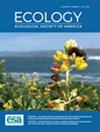Condo or cuisine? The function of fine woody debris in driving decomposition, detritivores, and their predators
IF 4.4
2区 环境科学与生态学
Q1 ECOLOGY
引用次数: 0
Abstract
Community structure and ecosystem function may be driven by the size or the energy within a given habitat, but these metrics (space and energy) are difficult to separate, especially in systems where the habitat itself is also food, such as detritus. Only a handful of studies have attempted to isolate potential mechanisms experimentally, which has left a notable knowledge gap in understanding the drivers of community structure and function. Here, we tested whether fine woody debris (FWD) affects leaf litter communities primarily as a source of space or energy. We used a crossed factor design to isolate the effects of FWD as space and energy, with four treatments: (1) no FWD, (2) only energy‐providing FWD (sawdust), (3) only space‐providing synthetic wood debris, and (4) a combination of both space and energy. We hypothesized that the highest levels of diversity, carnivore:detritivore ratio, and decomposition rate would occur on plots supplied with sawdust (representing energy), synthetic woody debris (representing space), or a combination of both, depending on the relative significance of FWD as a source of either energy or space. After 7 months, FWD as a source of energy but not space led to decreased decomposer abundance and richness. Conversely, increased proportion of carnivores and labile substrate decomposition was primarily driven by FWD as a source of space. However, the fastest decomposition of more recalcitrant substrates required both space and energy (additive), and the synergy of space and energy supported the greatest proportion of carnivores. These results suggest that the presence of FWD in forest ecosystems supports increased diversity and decomposition through a synergistic interaction of space and energy and the maintenance of deadwood like FWD in forest ecosystems can thus significantly contribute to forest ecosystem function.公寓还是美食?细木屑在推动分解、食腐动物及其捕食者方面的功能
群落结构和生态系统功能可能受特定栖息地大小或能量的驱动,但这些指标(空间和能量)很难分开,尤其是在栖息地本身也是食物(如残渣)的系统中。只有极少数研究试图通过实验来分离潜在的机制,这在理解群落结构和功能的驱动因素方面留下了明显的知识空白。在这里,我们测试了细木屑(FWD)是否主要作为空间或能量来源影响落叶层群落。我们采用交叉因子设计来分离细木碎屑作为空间和能量的影响,共有四个处理:(1) 无 FWD;(2) 仅提供能量的 FWD(锯末);(3) 仅提供空间的合成木屑;(4) 空间和能量的组合。我们假设,在提供锯末(代表能量)、合成木屑(代表空间)或二者结合的地块上,多样性、食肉动物与食腐动物的比例以及分解率都将达到最高水平,这取决于 FWD 作为能量或空间来源的相对重要性。7 个月后,FWD 作为能量来源而非空间来源会导致分解者的丰度和丰富度下降。相反,食肉动物和易腐基质分解比例的增加主要是由作为空间来源的 FWD 驱动的。然而,更难分解的基质的最快分解需要空间和能量(相加),空间和能量的协同作用支持了最大比例的食肉动物。这些结果表明,森林生态系统中枯落木的存在通过空间和能量的协同作用支持了多样性的增加和分解,因此,在森林生态系统中保持枯落木等枯死木可以极大地促进森林生态系统功能的发挥。
本文章由计算机程序翻译,如有差异,请以英文原文为准。
求助全文
约1分钟内获得全文
求助全文
来源期刊

Ecology
环境科学-生态学
CiteScore
8.30
自引率
2.10%
发文量
332
审稿时长
3 months
期刊介绍:
Ecology publishes articles that report on the basic elements of ecological research. Emphasis is placed on concise, clear articles documenting important ecological phenomena. The journal publishes a broad array of research that includes a rapidly expanding envelope of subject matter, techniques, approaches, and concepts: paleoecology through present-day phenomena; evolutionary, population, physiological, community, and ecosystem ecology, as well as biogeochemistry; inclusive of descriptive, comparative, experimental, mathematical, statistical, and interdisciplinary approaches.
 求助内容:
求助内容: 应助结果提醒方式:
应助结果提醒方式:


